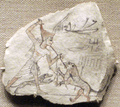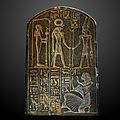Deshret facts for kids
Deshret was the special name for the Red Crown worn by the rulers of Lower Egypt. Lower Egypt was the northern part of ancient Egypt, near the Nile River delta.
When the Deshret (Red Crown) was combined with the Hedjet, which was the White Crown of Upper Egypt (the southern part), it formed the Pschent. This double crown was known as the sekhemti in ancient Egypt. The word "Deshret" also referred to the desert areas, called the Red Land, found on both sides of the Nile River.
In Egyptian language hieroglyphs, the Red Crown became the symbol for the vertical letter "n". This "n" hieroglyph, used since the Predynastic Period and the Old Kingdom, originally looked like ripples in water.
Contents
Why the Red Crown Was Important
In ancient Egyptian mythology, the god Geb, who was believed to be the first ruler of Egypt, gave Horus the power to rule over Lower Egypt. The Egyptian pharaohs, who saw themselves as the next rulers after Horus, wore the Deshret. This showed everyone their authority and control over Lower Egypt.
Other important gods also wore the deshret. For example, the protective serpent goddess Wadjet and the creator-goddess of Sais, Neith, were often shown wearing the Red Crown.
Later, the Red Crown was joined with the White Crown of Upper Egypt to create the Double Crown. This new crown was a strong symbol that showed the pharaoh ruled over the entire country, which they called "The Two Lands."
The Red Land, which included the deserts and lands outside Egypt, was thought to be ruled by the god Seth. Egyptians saw these desert areas as dangerous and wild places, without the order and laws found in Egypt itself.
What We Know About the Red Crown
Sadly, none of the actual Red Crowns have survived to this day. Because of this, we don't know exactly how the crowns were made or what materials were used. They might have been crafted from copper, reeds, cloth, or even leather.
The Red Crown is often seen in ancient Egyptian texts, carvings on walls, and statues. One of the earliest examples showing a pharaoh wearing the deshret is on the famous Narmer Palette. A record from the time of Djer, an early pharaoh, mentions a royal visit to a special shrine of the Deshret. This shrine might have been located in Buto, a city in the Nile delta.
No crown has ever been found buried with any pharaohs, even in tombs that were not robbed. This suggests that the Deshret was probably passed down from one king to the next, much like crowns are in royal families today.
-
The Narmer Palette
The Deshret Hieroglyph in Writing
The Red Crown symbol was used in hieroglyphic writing.
-
Apep being slain
Related Crowns
- Hedjet - This was the White Crown of Upper Egypt.
- Pschent - This was the Double Crown, combining the Red and White Crowns to show rule over all of Egypt.
Images for kids
-
The Rosetta Stone shows the Red Crown as part of the Pschent (Double Crown) and in the name "Taui" for Upper and Lower Egypt.
See also
 In Spanish: Deshret para niños
In Spanish: Deshret para niños










